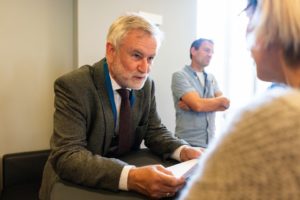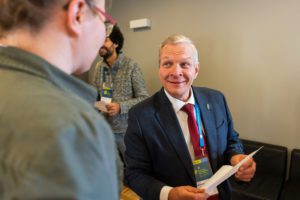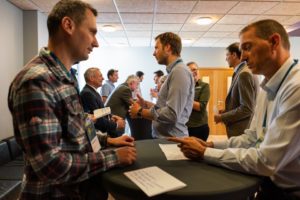Financing the Natura 2000 management: challenges & solutions
Workshop 1.1: Financing Natura 2000 management
During the Conference 2019 in Latvia, EUROPARC held a number of workshops to discuss diverse topics relevant for Protected Areas management. In case you have not attended, or want to read about their outcomes, a series of online articles summarises their content.
How much money do we need for effective Natura 2000 management?
In the workshop, inspired by the expertise of Micheal O’Briain – Deputy Head of Nature Protection Unit, DG Environment – European Commission, of Michael Hosek – EUROPARC Federation, Natura 2000 Commission chair and Juris Jātnieks – former director of the Nature Conservation Agency of Latvia, we tried to identify the main issues currently hampering successful planning and financing of Natura 2000 management. Taking advantage of the wide expertise of delegates, we also worked on possible solutions and action priorities.
The Natura 2000 network, which widely overlaps with nationally and regionally designated Protected Areas, is the largest network of protected sites in the world, with 27863 sites, covering about 18% of EU land and 9% of EU seas.
Several aspects were considered and discussed during the meeting. Among others:
From plans to management
If at a first glance, the need for funding seems to be the main urgency, the challenges appear to be more complex and wide. Money is not the solution per se, there are other crucial aspects to be considered: management and financial needs have to be clear; objectives have to be realistic but also ambitious; plans have to be developed consequently and be coherent with needs and objectives; plans with clear priorities can then be elaborated. Only this way we can ensure the management can be coherent and as effective as possible.
Prioritised Action Frameworks – PAFs

Micheal O’Briain at the EUROPARC Conference 2019.
For the effective management and restoration of this wide and complex network, ensuring sufficient funding is essential, with required investments estimated at about EUR 12 billion per year. Therefore the European Commission, with a view to optimise the use of EU funds has asked Member States to prepare what are called Prioritised Action Frameworks (PAFs). Those are made to identify strategic needs and funding priorities for investment in Natura 2000 and related Green Infrastructure.
These key planning tools will not only be directly relevant to helping ensure ambitious nature investments under the key sectoral funds (Common Agricultural Policy, Cohesion Policy, European Maritime and Fisheries Funds) but also for nature and biodiversity projects under the new EU LIFE regulation.
To effectively implement management plans and conservation measures, a careful and strategic planning and management of financial resources is therefore crucial. For this, PAFs – Prioritised Action Frameworks – developed at national/regional levels by the EU countries – are strategic tools.
Download the presentation ‘Strengthening investment in Natura 2000 and wider biodiversity under EU funds – the role of Prioritised Action Frameworks (PAFs) and LIFE funding‘, by Micheal O’Briain.
Current challenges for N2000 network
- The Natura 2000 network still needs to be finalised: there are still gaps mainly in the marine sector.
- There is the urgency to ensure that necessary management and restoration measures are in place, while promoting a better integration with other sectors (in particular with agriculture).
- Communication quality and effectiveness has to be improved. Weak communication of the opportunities and benefits that the Natura 2000 network provides. Improving communication is crucial to engage with other public sectors, with stakeholders and other partners.
- Lack of community and stakeholders engagement: solutions for Natura 2000 management have to be designed together.
- In general the environmental sector is too self oriented and lacks interaction with different sectors. Different perspectives need to be integrated. In particular, more connections to be established with the economic sector, with enterprises, agriculture and local communities.
Download the presentation ‘Introduction and overview from across Europe‘, by Michael Hosek.
Planning and management tools in Latvia

Juris jatnieks at the EUROPARC Conference 2019.
A National Conservation and Management Program for Natura 2000 sites has been developed for the whole country, for the period 2018 – 2030. This includes a prioritised list of management measures for all terrestrial NATURA 2000 area. A precious tool that helps to address priority measures for the qualifying features and the main conservation values of each particular NATURA2000 site. A crucial knowledge base for developers of site management plans, protected area site managers, spatial and development planners of municipalities and project managers.
There are also specific guidelines for protected habitat management. The guidelines describe field methods, suggest how to manage the existing habitat to improve status, or restore the habitat whenever it is possible and necessary. User-frendly indicators are included to evaluate the state of habitats, together with conclusions from experiments of management methods for dunes, grasslands, freshwater, mire and forest habitats.
Download the presentation ‘The Latvian experience in financing Natura 2000 and protected areas management’, by Juris Jātnieks.
Recommendations for action
Improving dialogue and building better relationships within the Natura 2000 network is clearly a priority. Specific knowledge, expertise and new skills are needed. The Natura 2000 network and wider protected area family would surely benefit from trained moderators and facilitators, with specific communication expertise. Those would help engaging with partners and stakeholders, help managing conflicts and contribute to improve the wide communication of N2000 benefits. Strategic communication plans have to be in place, data and facts have to be updated regularly, ready for dissemination. A wider audience have to be addressed and engaged to improve acceptance and support.
Together with strategic planning, good governance with clear decision making processes (who, what, how, when…) have to be in place: those are also crucial to make the management more effective.
Management and restoration practices and methods need to be shared and accessible.
Natura 2000 has to be well integrated in the overall National/Regional planning and management, as a crucial part of a unique ecological network, which includes other designated protected areas and the connecting green infrastructures.
The EU will be working on:
- European Green deal;
- A new EU Biodiversity Strategy to 2030 (Its structure will be developed by beginning of 2020);
- Improving the integration of biodiversity priorities within other relevant policies and funding;
- Strengthen the LIFE program and increase the resources allocated;
- Align climate and biodiversity debates.

Discussion in the Workshop 1.1 on financing Natura 2000 management.
EUROPARC shall:
- consider in the new strategy how contribute leading the coordination of the Natura 2000 network.
- continue working closely with the EC, influencing and informing priorities, while contributing to create opportunities for future.
- Engage and involve parks to improve the management of Natura 2000 sites.
- Support site managers to improve knowledge and expertise in Communication and other “soft – skills”.